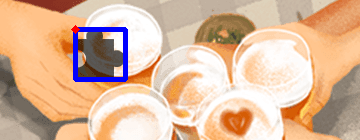Python + Selenium 实现模拟登录jd实例分享
1. 前言
最近有点时间,就随便找点东西弄弄,倒也碰到了一些问题,在此记录下
2. 环境
Python3.11.3 + selenium4.9.1 + opencv4.7 + PyAutoGUI0.9.54 + windows11
3. 开始
3.1 账号密码输入

进入登录页面,登录方式有两种,这里直接定位点击账号登录即可
|
1
2
3
4
5
6
7
8
9
10
11
12
|
# 进入登入页面self.driver.get(self.config.login_url)WebDriverWait(self.driver, 10).until(EC.url_to_be(self.config.login_url))self.driver.maximize_window() # 点击账号登录WebDriverWait(self.driver, 10).until(EC.element_to_be_clickable((By.XPATH, '//*[@class="login-tab login-tab-r"]/a')))self.driver.find_element(By.XPATH, '//*[@class="login-tab login-tab-r"]/a').click()# 账号密码输入self.driver.find_element(By.ID, "loginname").send_keys(self.user_info.username)self.driver.find_element(By.ID, "nloginpwd").send_keys(self.user_info.password) |
3.2 通过验证码

3.2.1 验证码图片下载
看到验证码的图片是base64格式的,可以通过src属性来获取,然后直接转成cv图片格式即可
|
1
2
3
4
5
6
7
8
9
|
bigimg_b64 = self.driver.find_element(By.XPATH, '//*[@class="JDJRV-bigimg"]/img').get_attribute('src')bigimg_data = base64.b64decode(bigimg_b64.replace('data:image/png;base64,', ''))bigimg_array = np.frombuffer(bigimg_data, np.uint8)bigimg_img = cv2.imdecode(bigimg_array, cv2.COLOR_RGB2BGR)smallimg_b64 = self.driver.find_element(By.XPATH, '//*[@class="JDJRV-smallimg"]/img').get_attribute('src')smallimg_data = base64.b64decode(smallimg_b64.replace('data:image/png;base64,', ''))smallimg_array = np.frombuffer(smallimg_data, np.uint8)smallimg_img = cv2.imdecode(smallimg_array, cv2.COLOR_RGB2BGR) |
3.2.2 滑块需要移动的距离计算




这里可以用opencv来做,正确率还不错,而且还简单,直接把两张验证码图片经过灰度后,进行模板匹配即可,不过最后的结果还需要根据网页元素的尺寸进行调整
|
1
2
3
4
5
6
7
8
9
10
|
# 灰度化bigimg_gray = cv2.cvtColor(bigimg_img, cv2.COLOR_BGR2GRAY)smallimg_gray = cv2.cvtColor(smallimg_img, cv2.COLOR_BGR2GRAY)# 模板匹配result = cv2.matchTemplate(bigimg_gray, smallimg_gray, cv2.TM_CCOEFF_NORMED)minVal, maxVal, minLoc, maxLoc = cv2.minMaxLoc(result)# 移动距离对应到网页需要缩放(网页显示的图片和实际图片存在一定的比例差异)x = minLoc[0] * (278.4 / 360.0) |
3.2.3 定位滑动按钮
之前一直使用selenium的ActionChains来操作滑块按钮,但是一直通不过,应该是jd有针对selenium有检测,后面参考了网上可以使用PyAutoGUI来控制鼠标来滑动,那就需要先定位到滑块的坐标,但是通过selenium获取的坐标还需要调整一下PyAutoGUI才能正确的定位到
|
1
2
3
4
5
|
WebDriverWait(self.driver, 10, 0.5).until(EC.presence_of_element_located((By.XPATH, '//*[@class="JDJRV-slide-inner JDJRV-slide-btn"]')))slide_btn = self.driver.find_element(By.XPATH, '//*[@class="JDJRV-slide-inner JDJRV-slide-btn"]')# TODO 网页元素位置映射到pyautogui会有一定缩放offset_x = slide_btn.location.get('x') * 1.30offset_y = slide_btn.location.get('y') * 1.75 |
3.2.4 模拟滑动
滑的时候发现上面opencv计算的移动距离还是有些偏差,还需要做些调整,而且滑动也得尽量拟人化,不然滑对了也通不过
|
1
2
3
4
5
6
7
8
9
10
11
12
13
14
15
16
17
18
19
20
21
22
23
24
25
26
27
28
|
# 直接滑到目标位置--会很难通过验证(用来调试移动距离是否正确)# pyautogui.moveTo(offset_x,offset_y,duration=0.1 + random.uniform(0,0.1 + random.randint(1,100) / 100))# pyautogui.mouseDown()# pyautogui.moveTo(offset_x + x * 1.25, offset_y, duration=0.28)# pyautogui.mouseUp()# TODO 根据验证码原图计算的移动距离也需要调一下缩放x = x * 1.25# 鼠标移动到滑块pyautogui.moveTo(offset_x,offset_y,duration=0.1 + random.uniform(0,0.1 + random.randint(1,100) / 100))# 按下鼠标pyautogui.mouseDown()offset_y += random.randint(9,19)# 开始滑动pyautogui.moveTo(offset_x + int(x * random.randint(15,25) / 20),offset_y,duration=0.28)offset_y += random.randint(-9,0)pyautogui.moveTo(offset_x + int(x * random.randint(17,23) / 20),offset_y, duration=random.randint(20,31) / 100)offset_y += random.randint(0,8)pyautogui.moveTo(offset_x + int(x * random.randint(19,21) / 20),offset_y, duration=random.randint(20,40) / 100)offset_y += random.randint(-3,3)pyautogui.moveTo(x + offset_x + random.randint(-3,3),offset_y,duration=0.5 + random.randint(-10,10) / 100)offset_y += random.randint(-2,2)pyautogui.moveTo(x + offset_x + random.randint(-2,2),offset_y,duration=0.5 + random.randint(-3,3) / 100)# 松开鼠标pyautogui.mouseUp() |
3.2.5 后续处理
到此基本上模拟登陆就完成了,避免失败,可以加个循环,滑块未通过时继续下一张,再做一些是否登录成功的验证就欧克啦。
4. 完整代码
https://github.com/QiuMiMi/Get-jd
到此这篇关于Python + Selenium 实现模拟登录jd实例分享的文章就介绍到这了,更多相关Python + Selenium 模拟登录jd内容请搜索脚本之家以前的文章或继续浏览下面的相关文章希望大家以后多多支持脚本之家!





 浙公网安备 33010602011771号
浙公网安备 33010602011771号